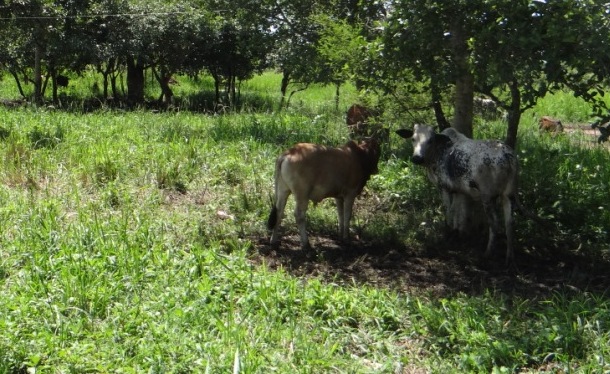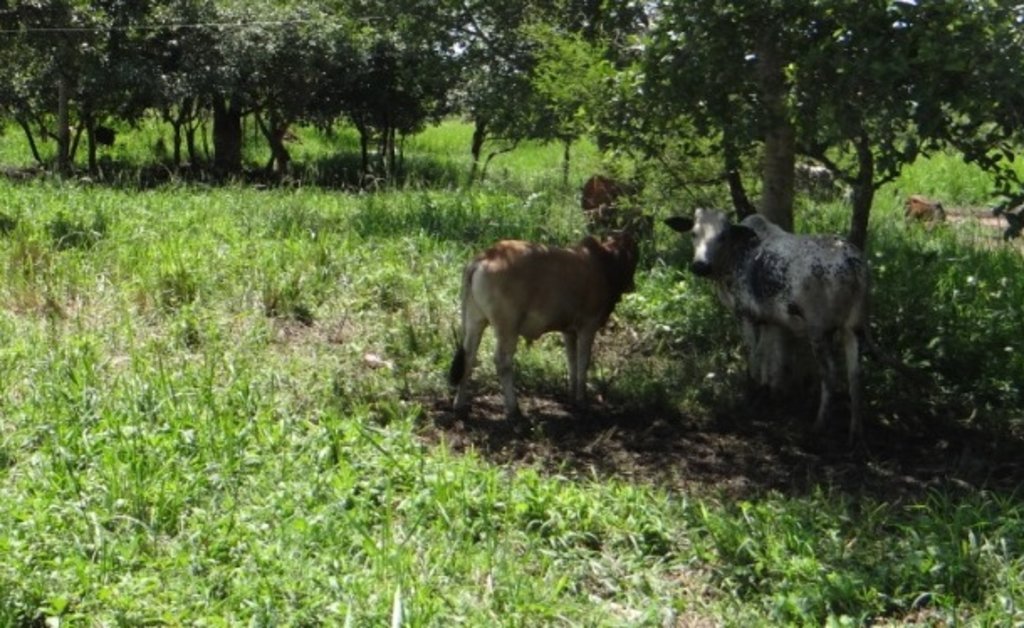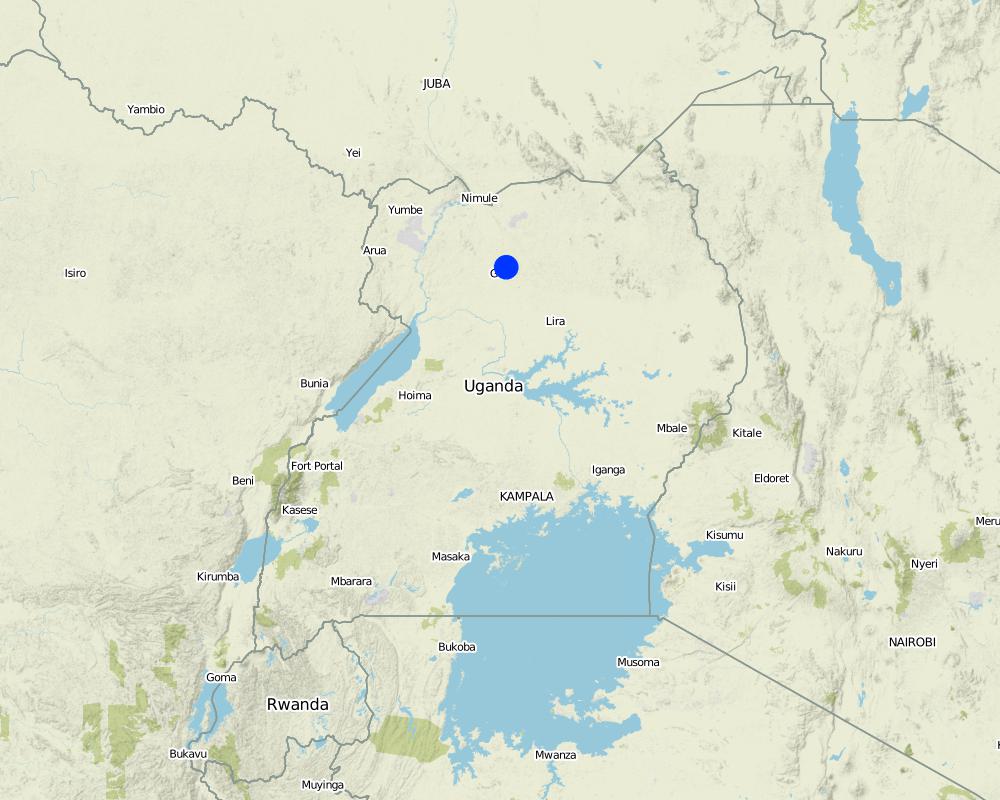Controlled livestock grazing for soil fertility improvement [乌干达]
- 创建:
- 更新:
- 编制者: Kamugisha Rick Nelson
- 编辑者: Bernard Fungo, Richard Otto Kawawa, JOY TUKAHIRWA
- 审查者: Rima Mekdaschi Studer, Renate Fleiner, Nicole Harari, John Stephen Tenywa, Donia Mühlematter
technologies_2761 - 乌干达
- Controlled livestock grazing for soil fertility improvement: July 16, 2018 (inactive)
- Controlled livestock grazing for soil fertility improvement: March 22, 2019 (inactive)
- Controlled livestock grazing for soil fertility improvement: May 22, 2018 (inactive)
- Controlled livestock grazing for soil fertility improvement: Aug. 19, 2024 (public)
- Controlled livestock grazing for soil fertility improvement: Aug. 11, 2019 (inactive)
查看章节
全部展开 全部收起1. 一般信息
1.2 参与该技术评估和文件编制的资源人员和机构的联系方式
关键资源人
土地使用者:
Ojok Robinson
Gulu District
Oding Village, Oding Parish, Onyama Sub-county, Gulu District
乌干达
有助于对技术进行记录/评估的项目名称(如相关)
Scaling-up SLM practices by smallholder farmers (IFAD)有助于对技术进行记录/评估的机构名称(如相关)
Uganda Landcare Network (ULN) - 乌干达1.3 关于使用通过WOCAT记录的数据的条件
(现场)数据是什么时候汇编的?:
24/05/2017
编制者和关键资源人员接受有关使用通过WOCAT记录数据的条件。:
是
1.4 所述技术的可持续性声明
这里所描述的技术在土地退化方面是否存在问题,导致无法被认为是一种可持续的土地管理技术?:
否
2. SLM技术的说明
2.1 技术简介
技术定义:
Integrated crop-livestock production for improved soil fertility management. Local cows are tied to trees to facilitate manure collection.
2.2 技术的详细说明
说明:
Controlled livestock grazing is a common practice promoted by farmers in Northern Uganda, who own up to 4-6 cows raised on two or more acres of land. Although the primary purpose is to produce milk for domestic consumption and for sale, the other subsidiary aim is to generate manure to replenish soil fertility on continuously cultivated and nutrient depleted land and pasture that the cows graze on. During the rainy season crops are planted and animals fed by cut and carry or pegged/ tied with a radius of 2-5 meters. During dry season the animals can graze on crop residues
For this technology, cattle are tethered/ tied on a pole (pegged) or tree using a sisal rope. Tethering distance should allow each cow to access pasture uninterrupted by others. The animals are rotated/ relocated routinely to minimise overgrazing in a given location. The manure produced is collected daily, and kept in heaps to compost for periods of 2 to 3 weeks, before being ferried to the fields for application for the cultivation of maize and other crops like soya bean . This technology requires possession of sufficient land for grazing the animals, as well as sufficient labour for handling manure through composting up to field application. The key inputs required for establishing this technology include labour, hand hoes, spades, sisal ropes, basins, sacks and basket for collecting manure and its transportation to the maize field, watering containers , spraying pumps for spraying animals against ticks and feeds to supplement the grazing during shortage of pasture.
The benefits derived from such a technology are both short and long term, including access to increased manure to apply on crop fields especially maize for increased production
To replicate this technology, the land user needs to have knowledge and skills on how to manage the animals to generate high quality manure, compost it and maintain it free of contamination with pesticides sprayed on the animals against pests and diseases, which may affect the quality of the manure and the safety of the users.
2.3 技术照片
2.4 技术视频
注释、简短说明:
Video showing Controlled grazing for soil fertility improvement in Gulu District, Northern Uganda.
日期:
26/05/2017
位置:
Gulu District, Northern Uganda
摄影师的名字:
Issa Aiga
2.5 已应用该技术的、本评估所涵盖的国家/地区/地点
国家:
乌干达
区域/州/省:
Northern Region
有关地点的进一步说明:
Gulu Municipality, Gulu District
注释:
Map showing Controlled livestock grazing technology site in Gulu District, Northern Uganda.
Map
×2.6 实施日期
注明实施年份:
2012
如果不知道确切的年份,请说明大概的日期:
- 不到10年前(最近)
2.7 技术介绍
详细说明该技术是如何引入的:
- 通过土地使用者的创新
- 通过项目/外部干预
注释(项目类型等):
Started on his own with only 2 cows and later National Agricultural Advisory Services (NAADS) and Operation Wealth Creation (OWC) supported him with training on management (rotating, feeding and animal manure application in the garden).
3. SLM技术的分类
3.1 该技术的主要目的
- 改良生产
- 减少、预防、恢复土地退化
- 创造有益的经济影响
3.2 应用该技术的当前土地利用类型

牧场
集约放牧/饲料生产:
- 收割和携带/零放牧

混合(作物/放牧/树木),包括农林
- 农林业
如果由于技术的实施而导致土地用途发生变化,则在技术实施前说明土地利的用途。:
Forest/ woodland: Selective felling.
3.3 有关土地利用的更多信息
该技术所应用土地的供水:
- 雨养
注释:
Normally two rain seasons March to May and September to December
每年的生长季节数:
- 2
具体说明:
per year. In Feb- March and Nov -December
牲畜密度(如相关):
Sarted with 2 and now has 16 cows and 7 goats. He bought some and others were given to him by friends
3.4 该技术所属的SLM组
- 农畜综合管理
- 土壤肥力综合管理
3.5 技术传播
具体说明该技术的分布:
- 均匀地分布在一个区域
如果该技术均匀地分布在一个区域上,请注明覆盖的大致区域。:
- < 0.1 平方千米(10 公顷)
3.6 包含该技术的可持续土地管理措施

农艺措施
- A2:有机质/土壤肥力
注释:
Manure collected is used on maize crop to increase maize production.
3.7 该技术强调的主要土地退化类型

化学性土壤退化
- Cn:肥力下降和有机质含量下降(非侵蚀所致)

生物性退化
- Bc:植被覆盖的减少
3.8 防止、减少或恢复土地退化
具体数量名该技术与土地退化有关的目标:
- 防止土地退化
- 减少土地退化
注释:
Decomposed manure when applied on the maize field increases production.
4. 技术规范、实施活动、投入和成本
4.1 该技术的技术图纸
作者:
Kaheru
日期:
24/05/2017
4.2 技术规范/技术图纸说明
The technical drawing only contains 4 -6 local cows that are tied on trees for manure provision and milk for sale. The recommendations to establish the technology are as follows: on a gentle sloping land of 2 acres of land or more measuring 50m wide and 100m Long with 4-6 cows the land user ties each cow on its own tree in a distance of 5-10 metres that allows access to grass and keep rotating the cows from one location to the other once grass reduces. The manure produced is collected on a daily basis, heaped and kept for a period of 2 to 3 weeks after which is carried using a sack, a basin or a basket to the maize plantation. Manure collected is and applied to the maize garden and spread at a thickness of approximately 1/2 inch.
4.3 有关投入和成本计算的一般信息
具体说明成本和投入是如何计算的:
- 每个技术单元
指定单位:
0.5 acres
指定体积、长度等(如果相关):
pegged/ tied with a radius of 2-5 meters
其它/国家货币(具体说明):
UGX
注明美元与当地货币的汇率(如相关):1美元=:
3445.0
注明雇用劳工的每日平均工资成本:
5000
4.4 技术建立活动
| 活动 | 措施类型 | 时间 | |
|---|---|---|---|
| 1. | Buy local cows/ varieties for keeping | 农业学的 | Once before stocking / dry season |
| 2. | Look for inputs , labour, sack, basins and ropes | 农业学的 | Before stocking |
| 3. | Tie the cows on a tree using a sisal rope | 其它措施 | During establishment |
| 4. | Plant the crop to provide crop residues | 农业学的 | During the wet season |
4.5 技术建立所需要的费用和投入
| 对投入进行具体说明 | 单位 | 数量 | 单位成本 | 每项投入的总成本 | 土地使用者承担的成本% | |
|---|---|---|---|---|---|---|
| 劳动力 | Planting | persons | 2.0 | 150000.0 | 300000.0 | 100.0 |
| 劳动力 | Tieing, feeding and grazing cows | persons | 2.0 | 150000.0 | 300000.0 | 100.0 |
| 设备 | Hoe | pieces | 1.0 | 10000.0 | 10000.0 | 1000.0 |
| 设备 | Spade | peices | 1.0 | 10000.0 | 10000.0 | 1000.0 |
| 设备 | Spraying pump | pieces | 1.0 | 250000.0 | 250000.0 | 100.0 |
| 设备 | Watering trays | pieces | 6.0 | 100000.0 | 600000.0 | 100.0 |
| 植物材料 | Maize seed | Kgs | 10.0 | 2500.0 | 25000.0 | 100.0 |
| 其它 | Local cows | cow | 6.0 | 700000.0 | 4200000.0 | |
| 其它 | Buckets | pieces | 1.0 | 3500.0 | 3500.0 | 100.0 |
| 其它 | Sack | pieces | 2.0 | 1000.0 | 2000.0 | 100.0 |
| 其它 | Feeds | Kgs | 100.0 | 4000.0 | 400000.0 | 100.0 |
| 其它 | Crop residues (not bought) | |||||
| 技术建立所需总成本 | 6100500.0 | |||||
注释:
Money used is got from sale of milk and also obtained a loan of 2,000,000 from a savings group.
4.6 维护/经常性活动
| 活动 | 措施类型 | 时间/频率 | |
|---|---|---|---|
| 1. | Watering the cow | 管理 | Daily during the dry season |
| 2. | Tieing and feeding the cow | 管理 | Daily |
| 3. | Spraying the cows against ticks | 管理 | Weekly |
| 4. | Heaping and carrying manure to the garden | 农业学的 | Everyday/ after 2 weeks |
| 5. | Applying manure in the soil | 农业学的 | Before planting season |
| 6. | Relocating the cows | 管理 | Every after 2 days |
| 7. | Cutting and carrying pasture | 管理 | After harvest |
4.7 维护/经常性活动所需要的费用和投入(每年)
| 对投入进行具体说明 | 单位 | 数量 | 单位成本 | 每项投入的总成本 | 土地使用者承担的成本% | |
|---|---|---|---|---|---|---|
| 劳动力 | Labour paid on monthly basis | Persons | 2.0 | 150000.0 | 300000.0 | 100.0 |
| 设备 | Replacement worn our equipment | pieces | 3.0 | 20000.0 | 60000.0 | 100.0 |
| 肥料和杀菌剂 | Pestcide | litres | 10.0 | 15000.0 | 150000.0 | 100.0 |
| 技术维护所需总成本 | 510000.0 | |||||
注释:
The land use employs 2 people on monthly basis watering, tieing , feeding, spraying, relocating carrying manure and cutting and carrying pasture. No equipment bought in short run since most of the equipment is bought at establishment. Only if there is need for replacement.
4.8 影响成本的最重要因素
描述影响成本的最决定性因素:
Labour takes the most costs since the tasks re routine compared to the cost of equipment which is bought and replaced after its worn out.
5. 自然和人文环境
5.1 气候
年降雨量
- < 250毫米
- 251-500毫米
- 501-750毫米
- 751-1,000毫米
- 1,001-1,500毫米
- 1,501-2,000毫米
- 2,001-3,000毫米
- 3,001-4,000毫米
- > 4,000毫米
指定年平均降雨量(若已知),单位为mm:
1350.00
农业气候带
- 潮湿的
5.2 地形
平均坡度:
- 水平(0-2%)
- 缓降(3-5%)
- 平缓(6-10%)
- 滚坡(11-15%)
- 崎岖(16-30%)
- 陡峭(31-60%)
- 非常陡峭(>60%)
地形:
- 高原/平原
- 山脊
- 山坡
- 山地斜坡
- 麓坡
- 谷底
垂直分布带:
- 0-100 m a.s.l.
- 101-500 m a.s.l.
- 501-1,000 m a.s.l.
- 1,001-1,500 m a.s.l.
- 1,501-2,000 m a.s.l.
- 2,001-2,500 m a.s.l.
- 2,501-3,000 m a.s.l.
- 3,001-4,000 m a.s.l.
- > 4,000 m a.s.l.
说明该技术是否专门应用于:
- 凹陷情况
5.3 土壤
平均土层深度:
- 非常浅(0-20厘米)
- 浅(21-50厘米)
- 中等深度(51-80厘米)
- 深(81-120厘米)
- 非常深(> 120厘米)
土壤质地(表土):
- 中粒(壤土、粉土)
土壤质地(地表以下> 20厘米):
- 中粒(壤土、粉土)
表土有机质:
- 中(1-3%)
5.4 水资源可用性和质量
地下水位表:
< 5米
地表水的可用性:
中等
水质(未处理):
良好饮用水
水的盐度有问题吗?:
是
具体说明:
Presence of borehole
该区域正在发生洪水吗?:
否
关于水质和水量的注释和进一步规范:
The bore hole is seasonal - shortage of water during the dry season.
5.5 生物多样性
物种多样性:
- 中等
栖息地多样性:
- 中等
5.6 应用该技术的土地使用者的特征
定栖或游牧:
- 定栖的
生产系统的市场定位:
- 混合(生计/商业
非农收入:
- 低于全部收入的10%
相对财富水平:
- 平均水平
个人或集体:
- 个人/家庭
机械化水平:
- 手工作业
- 畜力牵引
性别:
- 女人
- 男人
土地使用者的年龄:
- 青年人
- 中年人
说明土地使用者的其他有关特征:
The land user plans to buy exotic cows for zero grazing to provide more animal manure and milk for sale
5.7 应用该技术的土地使用者拥有或租用的平均土地面积
- < 0.5 公顷
- 0.5-1 公顷
- 1-2 公顷
- 2-5公顷
- 5-15公顷
- 15-50公顷
- 50-100公顷
- 100-500公顷
- 500-1,000公顷
- 1,000-10,000公顷
- > 10,000公顷
这被认为是小规模、中规模还是大规模的(参照当地实际情况)?:
- 小规模的
注释:
Very unproductive land but the farmer slowly improving it with manure from the kept cows.
5.8 土地所有权、土地使用权和水使用权
土地所有权:
- 个人,未命名
土地使用权:
- 个人
用水权:
- 社区(有组织)
5.9 进入服务和基础设施的通道
健康:
- 贫瘠
- 适度的
- 好
教育:
- 贫瘠
- 适度的
- 好
技术援助:
- 贫瘠
- 适度的
- 好
就业(例如非农):
- 贫瘠
- 适度的
- 好
市场:
- 贫瘠
- 适度的
- 好
能源:
- 贫瘠
- 适度的
- 好
道路和交通:
- 贫瘠
- 适度的
- 好
饮用水和卫生设施:
- 贫瘠
- 适度的
- 好
金融服务:
- 贫瘠
- 适度的
- 好
6. 影响和结论性说明
6.1 该技术的现场影响
社会经济效应
生产
畜牧生产
注释/具体说明:
Milk production and the farmer has also increased the number of cows.
土地管理
注释/具体说明:
Application of locally obtained manure.
收入和成本
农业投入费用
注释/具体说明:
More money spent on buying pesticides, basins, buckets, and maize seed.
农业收入
注释/具体说明:
From sale of maize and milk.
工作量
注释/具体说明:
More activities during establishment.
社会文化影响
食品安全/自给自足
注释/具体说明:
Availability of Maize after harvest for sale and household income.
SLM/土地退化知识
注释/具体说明:
Training on manure application in the maize field.
生态影响
土壤
土壤覆盖层
注释/具体说明:
Use of manure and maize stalks.
土壤流失
注释/具体说明:
Application of manure and decomposition of maize stalks.
6.2 该技术的场外影响已经显现
对邻近农田的破坏
注释/具体说明:
Restricted movements of the cows
6.3 技术对渐变气候以及与气候相关的极端情况/灾害的暴露和敏感性(土地使用者认为的极端情况/灾害)
渐变气候
渐变气候
| 季节 | 气候变化/极端天气的类型 | 该技术是如何应对的? | |
|---|---|---|---|
| 年温度 | 增加 | 适度 | |
| 季节性温度 | 旱季 | 增加 | 适度 |
气候有关的极端情况(灾害)
生物灾害
| 该技术是如何应对的? | |
|---|---|
| 流行病 | 好 |
6.4 成本效益分析
技术收益与技术建立成本相比如何(从土地使用者的角度看)?
短期回报:
稍微积极
长期回报:
非常积极
技术收益与技术维护成本/经常性成本相比如何(从土地使用者的角度看)?
短期回报:
稍微积极
长期回报:
积极
注释:
More benefits after establishments.
High costs during establishment.
6.5 技术采用
- 1-10%
在所有采用这项技术的人当中,有多少人是自发地采用该技术,即未获得任何物质奖励/付款?:
- 0-10%
6.6 适应
最近是否对该技术进行了修改以适应不断变化的条件?:
否
6.7 该技术的优点/长处/机会
| 土地使用者眼中的长处/优势/机会 |
|---|
| Yield potential is high with good feeding of the cows , right spacing and manure application in maize garden. |
| The technology can easily be replicated by small scale and large scale land users to other areas. |
| Uses sisal ropes which are cheap. |
| 编制者或其他关键资源人员认为的长处/优势/机会 |
|---|
| Minimizes conflicts when cows are tied in one area. |
| Good at providing income and manure for soil fertility improvement. |
6.8 技术的弱点/缺点/风险及其克服方法
| 土地使用者认为的弱点/缺点/风险 | 如何克服它们? |
|---|---|
| Requires constant labour. | Use family labour to supplement hired labour. |
| Requires technical knowledge on management, spacing and treatment. | Seek technical advice from the extension worker. |
| 编制者或其他关键资源人员认为的弱点/缺点/风险 | 如何克服它们? |
|---|---|
| Easily affected by pests and diseases. | Apply pesticides / seek technical advice from the extension worker. |
7. 参考和链接
7.1 信息的方法/来源
- 实地考察、实地调查
01
- 与土地使用者的访谈
01
链接和模块
全部展开 全部收起链接
无链接
模块
无模块





